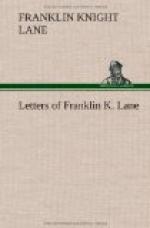From those who knew him best from childhood, no word of him is left, and none from the two men whose strength and ideality colored his morning at the University of California—Dr. George H. Howison, the “darling Howison” of the William James’ Letters, and Dr. Joseph H. Le Conte, the wise and gentle geologist. “Names that were Sierras along my skyline,” Lane said of such men. To Dr. Howison he wrote in 1913, when entering President Wilson’s Cabinet, “No letter that I have ever received has given me more real pleasure than yours, and no man has been more of an inspiration than you.”
The sealing of almost every source of intimate knowledge of the boy, who was a mature man at twenty-two, has left the record of the early period curiously scant. Fortunately, there are in his letters and speeches some casual allusions to his childhood and youth, and a few facts and anecdotes of the period from members of his family, from school, college, and early newspaper associates. In 1888, the story begins to gather form and coherence, for at that date we have the first of his own letters that have been preserved, written to his lifelong friend, John H. Wigmore. With many breaks, especially in the early chapters, the sequence of events, and his moods toward them, pour from him with increasing fullness and spontaneity, until the day before he died.
All the later record exists in his letters, most of them written almost as unconsciously as the heart sends blood to the remotest members of the body; and they come back, now, in slow diastole, bearing within themselves evidence of the hour and day and place of their inception; letters written with the stub of a pencil on copy-paper, at some sleepless dawn; or, long ago, in the wide-spaced type of a primitive traveling typewriter, and dated, perhaps, on the Western desert, while he was on his way to secure water for thirsty settlers; or dashed off in the glowing moment just after a Cabinet meeting, with the heat of the discussion still in his veins; others on the paper of the Department of the Interior, with the symbol of the buffalo—chosen by him—richly embossed in white on the corner, and other letters, soiled and worn from being long carried in the pocket and often re-read, by the brave old reformer who had hailed Lane when he first entered the lists. This is the part of the record that cannot be transcribed.




